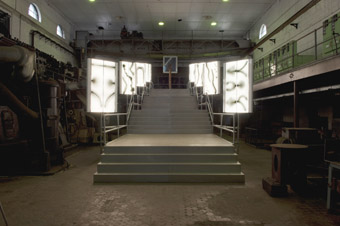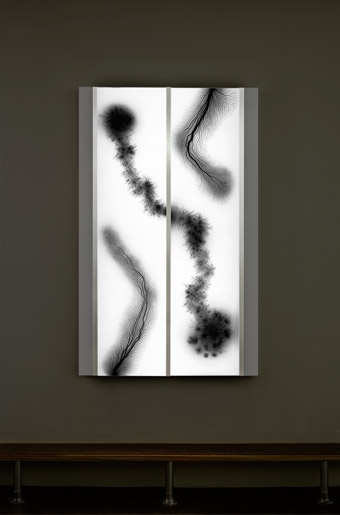genius loci, sparks and arcs
gary warner: hiroshi sugimoto, 17th biennale of sydney

Faraday Cage, 2010 Installation view of the Biennale of Sydney 2010, Power House, Cockatoo Island, courtesy the artist and Gallery Koyanagi, Tokyo
photo Sebastian Kriete
Faraday Cage, 2010 Installation view of the Biennale of Sydney 2010, Power House, Cockatoo Island, courtesy the artist and Gallery Koyanagi, Tokyo
HIROSHI SUGIMOTO IS AN ARTIST WHO USES PHOTOGRAPHY TO EXPLORE AND REALISE CONCEPTS ARISING FROM HIS WIDE-RANGING INTERESTS SPANNING ART, SCIENCE, LANDSCAPE, MATHEMATICS, BELIEF SYSTEMS AND ARCHITECTURE
He uses large-format cameras to create portraits of ideas—often to record light events over long time spans—creating revelatory images otherwise unavailable to human perception. For example, the brief but entire life of a candle or the duration of a movie projected on a cinema screen. In sculptural and architectural forms, he uses materials such as plaster or aluminium to explore the potentialities of shadows and abstract geometries.
For the 17th Biennale of Sydney, Sugimoto devised Faraday Cage, a new site-specific work located inside the decommissioned power station at the western end of Sydney Harbour’s Cockatoo Island.
Here and now, in the early 21st century, Cockatoo Island presents a unique palimpsest of maritime industrial activity and technologies, at once embodied and entombed in a utilitarian accumulation of remnant architectures watched over by the emblematic rusting carcasses of eerily figurative monumental cranes. Across, over and through this savagely cut and gouged sandstone mound, untold kilometres of cables, pipes and conduits trace the entire trajectory of the Industrial Revolution. And all of these systems, devices and machines required power to function—provided in stages by the muscles of men and horses, the circulatory energy of steam and fantastic, mysterious, elemental electricity.
After a long wander down a bitumen road between a towering sandstone quarry cliff and a narrow deepwater dock, the approach to Faraday Cage is via a short oversized tunnel carved through the island’s sandstone body. Behind a giant’s ribcage of angular steel trusses, roughly hewn stone walls drip with seeping rainwater. Rounding a bend, a small accidental atrium space serves as outdoor ante-room to the power station proper. Massive monochrome-grey triple-height wooden doors stand closed at the entrance. Faraday Cage is inside.
Common to the industrial vernacular, a much smaller secondary door is cut near ground level into one of the two huge swing-doors. Reminiscent of the experiential commencement of chanoyu, the Japanese tea ceremony, visitors must stoop to enter the building containing the artwork. There’s a brief moment of instinctual care taken as one steps over this awkward threshold, bent toward the floor. On standing upright again, the shadowed, cavernous space of the defunct power station interior is revealed.
High up, a massive gantry crane sits motionless. Hugging one wall on a raised walkway is a procession of tall metal cabinets adorned with rows of white dials and black switches. An open stairwell of rusted steel descends to an ominous dark void. Down there, the relentless sound of a strong flow of water—an underground stream? Huge iron tubes like taut muscular arms, spherical mesh cages, Frankenstein throw-switches, precision rows of bakelite dials, warning signs—everything here is about containment and flow of enormous pressures and deadly forces. This is energy bondage fetishism born of engineering necessity. Over there, worn wooden workbenches with careless assemblages of abstract metal shapes, rusted drums, stained walls, stained puddles…it is a space filled powerfully with absence. And to this redundant post-industrial setting, Sugimoto introduces various interventions, asserting a different potential.
Of immediate visual impact, the artist has contrived a grand, temporary stairway delineated by steel-pipe bannisters to dominate the central void. Ascending dramatically away from the viewer, it is punctuated with a series of four broad metal platforms, each flanked by a pair of large vertical light-boxes displaying exquisite, luminous examples of Sugimoto’s recent experiments in producing photography with (not of) static electricity.

Hiroshi Sugimoto, Lightning Fields Illuminated 003 | 2008 black-and-white film with light box
courtesy the artist and Gallery Koyanagi, Tokyo
Hiroshi Sugimoto, Lightning Fields Illuminated 003 | 2008 black-and-white film with light box
These glowing dendritic monochromes serve as symbolic portraits of the friendship between two 19th century ‘natural philosophers.’ Michael Faraday and William Henry Fox Talbot. Faraday’s investigations led to the industrial development of electricity, while Fox Talbot invented calotype photography and used it as a medium for artistic expression. They were both progenitors in the maelstrom of invention that was the Industrial Revolution—within which legacy we now reside.
Atop the stairwell, which commingles industrial make-do with mnemonic tropes from grand theatre foyers, banal hotel lobbies and aristocratic homes, stands a crude wooden column. Astride this column, above the heads of visitors, is an extraordinary menacing figure—an emanation of elemental power, of lightning’s hair-raising cohort, Raijin the Japanese deity of Thunder. Leaping across time and space from 13th century Japan, this arresting polychrome wooden incarnation expresses the energy of thunder as a bulging, squat, blood-red daemon, fierce mouth agape, green-glass eyes madly staring, oversized golden loin-wrap swirling as he runs across the sky beating great invisible drums with double-headed mallets clenched in brutish fists.
This astounding sculpture—so beautifully conceived and skilfully executed—represents a deity with obscure origins in both Indian Hinduism and Chinese Taoism, adapted into Japanese animist traditions and finally into Buddhism as one of the many protectors of Kannon (Avalokitesvara), the 1,000-Armed Bodhisattva of Infinite Compassion. Long before, Raijin attempted to frighten and menace the Buddha, but after becoming a protector of the dharma, he is said to have saved the islands of Japan from invasion by Mongolian forces in 1274. He stood atop the clouds hurling spears of lightning down upon their fleet.
But 13th century Raijin is not the only deity invoked within the charged atmosphere of Faraday Cage. Sugimoto effortlessly reaches back and forth across time, bringing diverse ‘cultural warriors’ together on the stage of his contemporary art practice. If Faraday and Fox Talbot are tangentially evoked, another ‘giant’ of a different order is made unmistakably apparent.
Near the entrance is a well-known photographic portrait of Marcel Duchamp, elucidating an explicit and appropriately tongue-in-cheek reference to the readymade quality of this amazing building/space. The glass in the frame has been damaged by what appear to be a few light hammer blows, and it’s attached to an old two-wheeled hand-pushed goods trolley. Duchamp—and the weight of his conceptual baggage—has been literally wheeled out and parked in the space.
Nearby and behind, camouflaged within the tangle of decommissioned industrial debris, is a Faraday Cage apparatus, named after Michael Faraday’s invention of 1836. This esoteric example of the device incorporates a common metal bird cage, symbolically referencing the capture and taming of elemental forces for human amusement. The Faraday Cage hides there, apparently dormant but silently accumulating immense and invisible power, until periodically discharging its pent-up electrical energy with startling, noisy arcs of blue-white miniature lightning.
The overall effect is of a strange, dimly lit cathedral-like space. It is at once a homage to and mutation from its original purpose, becoming a place for the generation of speculation on art, science and technology, and for the temporary worship of harnessed elemental forces. Perhaps it includes one which is everywhere apparent in this part-industry, part-art hybrid tableau—the elemental force of the human imagination. The imagination to portray epic deities to explain the terrifying indifferent fury of natural forces. The imagination to radically investigate those same forces and derive different explanations in substitution of deities. The imagination to devise technologies to cage and tame and apply those forces. And the imagination to conjure and realise utterly different forms of art—a urinal as sculpture, electricity as a photograph, decayed post-industrial hulk as contemporary art space.
Hiroshi Sugimoto’s Faraday Cage points directly to this cascade of minds falling through time, sparkling with erratic energies.
Hiroshi Sugimoto, Faraday Cage 17th Biennale of Sydney, Cockatoo Island, May 12-Aug 1
This article first appeared online, June 28, 2010
RealTime issue #98 Aug-Sept 2010 pg. 34






